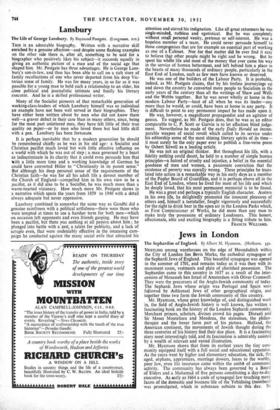Jews in London
The Sephardim of England. By Albert M. Hyamson. (Methuen. 35s.
NESTLING among warehouses on the edge of Houndsditch within the City of London lies Bevis Marks; the cathedral synagogue of the Sephardi Jews of England. This beautiful synagogue was opened in the summer of 1701, and remains today as it was then with its muniment room, vestments and plate of cherished possession. The Sephardim came to this country in 1657 as a result of the inter- cession of Menasseh ben Israel of Amsterdam with Oliver Cromwell. They were the precursors of the Anglo-Jewish community of today. The Sephardi Jews whose origin was Portugal and Spain were folllowed by 'Ashkenazi Jews of other geographical origin, and together these two form the Jewish community of this country. Mr. Hyamson, whose great knowledge of, and distinguished work in, the field of Anglo-Jewish history is well known, has written a fascinating book on the history of the London Sephardi community. Merchant princes, scholars, divines crowd his pages. Disraeli and Sir Moses Montefiore and Mendoza, the statesman, the philan- thropist and the boxer form part of his picture. Holland, the American continent, the movements of Jewish thought during the three centuries of his history find their due place. It is a fascinating story most interestingly told, and its fascination is admirably assisted by a wealth of relevant and varied illustration. Mr. Hyamson shows that from its earliest years the tiny com- munity equipped itself with a full social and educational apparatus. As the years went by higher and elementary education, the sick, the aged, orphans, apprentices, marriage dowers, loans to the worthy, poor law, even life insurance came within the ambit of communal activity. The community has always been governed by a Board of Elders and a Mahamad of five persons constituting a day-to-day executive. As early as 1664 a code of synagogal law touching many facets of the domestic and business life of the Yehiclising (members) - was promulgated, which in substance subsists to this day. So adherent to tradition were the members of this community that until 1819 Portuguese was the language of their laws, their business and their minutes. Only as late as 1831 were the laws of the synagogue promulgated in English. Today there still remain many occasions upon which the ancient use of Spanish and Portuguese is maintained. Mr. Hyamson shows admirably how this community wedded to and steeped in tradition has slowly and conservatively assumed a modicum of modern trappings.
A most useful appendix by the Hakam of the Congregation, its chief minister, learnedly and interestingly gives an account of the changes in ritual and order of services. Mr. Hyamson has printed lists of the founders of the congregation, the seat-holders of 5442 (1682), the earliest elder and the members of the Mahamad. The names again and again recall the ancient grandee names of Portugalsand Spain and resound with the music of words.
Two small mistakes in the glossary demand mention. The plural of Beth Din is Bate Din and Fintador is spelt without a final " e." This book is emphatically one to be read by a wide circle. It has far more than a Jewish interest. Evidence of scholarship and research is patent upon every page. Mr. Hyamson was born within an Ashkenazi milieu and is now an elected and full member of the Sephardi community. That Sephardi community is proud to have him among its ranks, and will treasure his bpok not least for the affectionate and dutiful sense of obligation which has inspired its



































 Previous page
Previous page